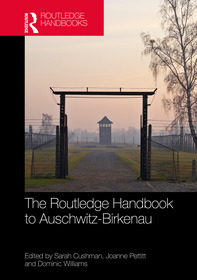
The Routledge Handbook to Auschwitz-Birkenau
-
10% KEDVEZMÉNY?
- A kedvezmény csak az 'Értesítés a kedvenc témákról' hírlevelünk címzettjeinek rendeléseire érvényes.
- Kiadói listaár GBP 230.00
-
109 882 Ft (104 650 Ft + 5% áfa)
Az ár azért becsült, mert a rendelés pillanatában nem lehet pontosan tudni, hogy a beérkezéskor milyen lesz a forint árfolyama az adott termék eredeti devizájához képest. Ha a forint romlana, kissé többet, ha javulna, kissé kevesebbet kell majd fizetnie.
- Kedvezmény(ek) 10% (cc. 10 988 Ft off)
- Kedvezményes ár 98 894 Ft (94 185 Ft + 5% áfa)
Iratkozzon fel most és részesüljön kedvezőbb árainkból!
Feliratkozom
109 882 Ft

Beszerezhetőség
Becsült beszerzési idő: A Prosperónál jelenleg nincsen raktáron, de a kiadónál igen. Beszerzés kb. 3-5 hét..
A Prosperónál jelenleg nincsen raktáron.
Why don't you give exact delivery time?
A beszerzés időigényét az eddigi tapasztalatokra alapozva adjuk meg. Azért becsült, mert a terméket külföldről hozzuk be, így a kiadó kiszolgálásának pillanatnyi gyorsaságától is függ. A megadottnál gyorsabb és lassabb szállítás is elképzelhető, de mindent megteszünk, hogy Ön a lehető leghamarabb jusson hozzá a termékhez.
A termék adatai:
- Kiadás sorszáma 1
- Kiadó Routledge
- Megjelenés dátuma 2025. augusztus 12.
- ISBN 9781032202440
- Kötéstípus Keménykötés
- Terjedelem450 oldal
- Méret 246x174 mm
- Súly 990 g
- Nyelv angol
- Illusztrációk 11 Illustrations, black & white; 11 Halftones, black & white; 8 Tables, black & white 686
Kategóriák
Rövid leírás:
This handbook examines Auschwitz-Birkenau as both a site and a symbol of Nazi genocide. Scholars from a range of disciplinary perspectives consider Auschwitz’s history by engaging with Holocaust historiography and its place in Holocaust memory and representation, illustrating their mutual influence.
Több
Hosszú leírás:
This handbook examines Auschwitz-Birkenau as both a site and a symbol of Nazi genocide. Scholars from a range of disciplinary perspectives consider Auschwitz’s history by engaging with Holocaust historiography and its place in Holocaust memory and representation, illustrating their mutual influence.
The chapters bring new insights to topics that other studies of Auschwitz have explored before, such as the Sonderkommando, the Czech family camp, and literary representations of Auschwitz. Other chapters cover recent developments and more neglected areas, such as the experience and memory of Romani prisoners, the fate of Soviet prisoners of war, and Auschwitz’s presence on social media. The handbook also responds to a number of recent trends and new paradigms in Holocaust Studies, including contributions from the fields of Environmental Studies, Spatial Studies, and Gender Studies.
As a crucial overview of the topic of Auschwitz-Birkenau and an introduction to its most recent and fruitful scholarly approaches, this handbook will be a valuable resource for undergraduates from second year and up, as well as for graduate students and researchers seeking a survey of the field.
TöbbTartalomjegyzék:
Introduction Section 1: Placing Auschwitz 1. Auschwitz and the SS Concentration Camp System 2. Mapping Auschwitz 3. Thinking Auschwitz Spatially 4. The Auschwitz Environment 5. Auschwitz and Its Locale Section 2: Prisoner Groups 6. O Drom o Rromano k’o Aušvic (The Romani Road to Auschwitz) 7. The Theresienstadt Family Camp in Auschwitz 8. Prisoner of War Camp Auschwitz 9. Children in Auschwitz-Birkenau 10. The Auschwitz Sonderkommando Section 3: Experiences of Community and Suffering 11. Food and Hunger at Auschwitz 12. The “Muselmann” in Auschwitz 13. Music Making as Community Formation in Auschwitz-Birkenau: The Case of Krystyna Żywulska 14. Torah and Mitzvahs in Hell: Jewish Religious Activity in Auschwitz-Birkenau Section 4: Perpetrators and Collaborators 15. Auschwitz and Its Imagery 16. SS Affiliated Women in Auschwitz 17. Civilian Workers on Site 18. The First Frankfurt Auschwitz Trial, 1963–1965 Section 5: Representing Auschwitz 19. Auschwitz and Fiction 20. Seeing Auschwitz: The Nazi Gaze in Auschwitz Perpetrator Fiction 21. “Auschwitz Still Lives and Breathes in Me”: Auschwitz-Birkenau in Romani Writing 22. Images of Auschwitz in Graphic Novels 23. Filming Auschwitz Section 6: Key Figures in Cultural Memory 24. Hermann Langbein: Remembering as Political Practice 25. Charlotte Delbo 26. Arriving at Auschwitz with Elie Wiesel 27. Born of Fire: Yehiel Dinur (Ka-Tzetnik)’s Literary Testimony to Auschwitz 28. Primo Levi: The Duty of Testimony Section 7: Global Auschwitz 29. The Meaning of the Barbed Wire: Auschwitz’s Place and Holocaust Memory in Brazil 30. Translating and Writing Auschwitz into Chinese Literature 31. Polish Perceptions of Auschwitz 32. Representing Horror: Auschwitz-Birkenau in Israeli Documentary Cinema Section 8: Postwar Reflections and Engagements 33. Auschwitz as a Political-Philosophical Problem 34. "We Remind People Daily. Again and Again": The Role(s) of the Auschwitz-Birkenau State Museum’s Social Media 35. Tourism at Auschwitz
Több



